Census.gov › Data › Data Visualization Gallery › Center of Population and Territorial Expansion, 1790-2010
Data
Center of Population and Territorial Expansion, 1790-2010
February 7, 2013
The mean center of population is the place where an imaginary, flat, weightless, and rigid map of the United States would balance perfectly if all residents were of equal weight. Historically, the movement of the center of population has reflected the expansion of the country, the settling of the frontier, waves of immigration and migration west and south. Since 1790, the center of population has moved steadily westward, angling to the southwest in recent decades.
SOURCE: Geography Division, "Centers of Population Computation for the United States 1950-2010," issued March 2011, available at http://www.census.gov/geo/www/2010census/centerpop2010/COP2010_documentation.pdf. Consulted for historical reference: Historical Atlas of the United States, National Geographic Society, 1988.
NOTE: The Proclamation Line of 1763 limited British settlement to areas east of the Appalachian Mountains. Alaska and Hawaii were not included in the calculation of the mean center of population until 1950. Puerto Rico was not included in any decade. For more information on the mean center of population, an animated map, and other resources, see http://www.census.gov/geo/www/2010census/centerpop2010/centerpop2010.html. This graphic is adapted from the "Census Atlas of the United States" published by the Census Bureau in 2007. More information about this publication is available at http://www.census.gov/population/www/cen2000/censusatlas/.
Recent Data Visualizations
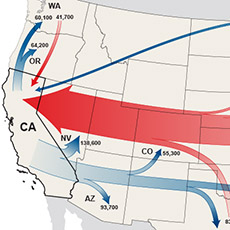 Migration Between Calif. & Other States
Migration Between Calif. & Other States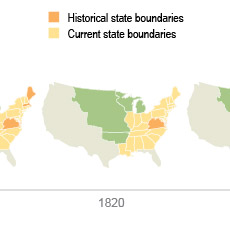 U.S. Territory and Statehood Status
U.S. Territory and Statehood Status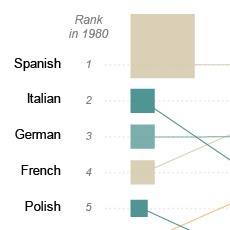 Spoken Languages Other than English
Spoken Languages Other than English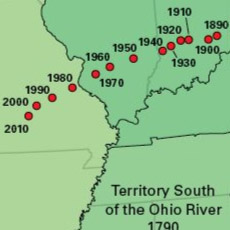 Center of Population, 1790-2010
Center of Population, 1790-2010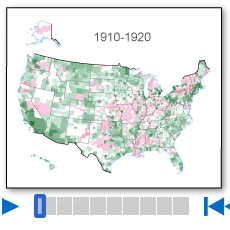 Population Change by Decade
Population Change by Decade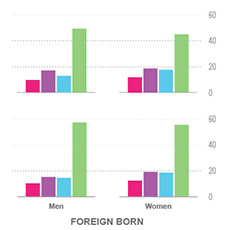 Without A High School Education
Without A High School Education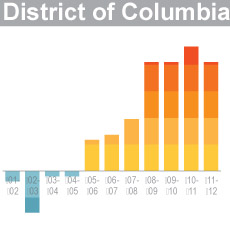 A Decade of State Population Change
A Decade of State Population Change State-to-State Migration for States of 8 Million or More
State-to-State Migration for States of 8 Million or More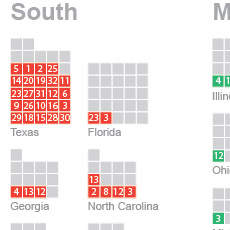 Population Under 5 Years Old by Congressional District
Population Under 5 Years Old by Congressional District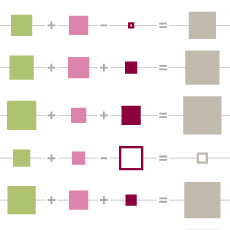 Components of Metro Area Change
Components of Metro Area Change Blooming States
Blooming States Coastline County Population
Coastline County Population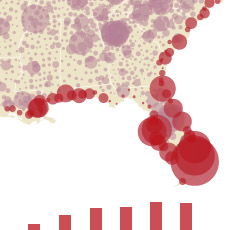 Coastline County Population
Coastline County Population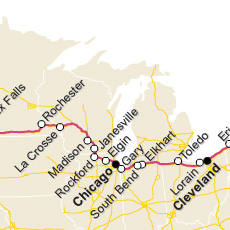 I-90 Population Density Profile, 2010
I-90 Population Density Profile, 2010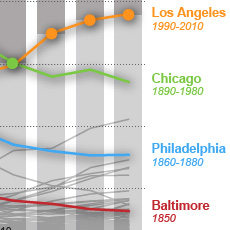 Second Cities: Keeping Pace with a Booming New York
Second Cities: Keeping Pace with a Booming New York By the Grid: Population Shift to the West and South
By the Grid: Population Shift to the West and South I-10 Population Density Profile, 2010
I-10 Population Density Profile, 2010 Booming Cities Decade-to-Decade, 1830-2010
Booming Cities Decade-to-Decade, 1830-2010 I-5 Population Density Profile, 2010
I-5 Population Density Profile, 2010 Islands of High Income
Islands of High Income The Great Migration, 1910 to 1970
The Great Migration, 1910 to 1970 Following the Frontier Line, 1790 to 1890
Following the Frontier Line, 1790 to 1890 Changing Ranks of States by Congressional Representation
Changing Ranks of States by Congressional Representation Cartograms of State Populations in 1890, 1950, and 2010
Cartograms of State Populations in 1890, 1950, and 2010 Before and After 1940: Change in Population Density
Before and After 1940: Change in Population Density From Physical to Political Geography
From Physical to Political Geography Differential City Growth Patterns
Differential City Growth Patterns I-95 Population Density Profile
I-95 Population Density Profile Increasing Urbanization
Increasing Urbanization Gaining and Losing Shares
Gaining and Losing Shares Top 20 Cities
Top 20 Cities

 Email Updates
Email Updates Facebook
Facebook Twitter
Twitter Flickr
Flickr YouTube
YouTube